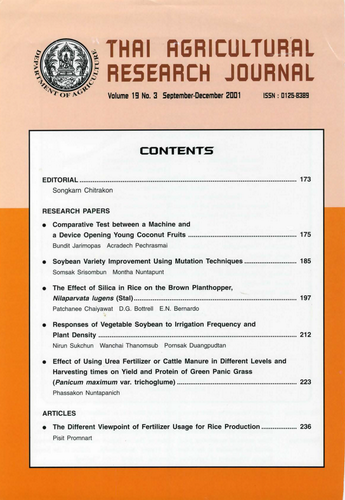The Effect of Silica in Rice on the Brown Planthopper, Nilaparvata lugens (Stal)
Keywords:
rice varieties, genetic resistance, silica, brown planthopperAbstract
The study determined the effect of silica in rice (Oryza sativa L.) plants on the brown planthopper (BPH), Nilaparvata lugens (Stal). five rice varieties withy different levels of genetic resistance to BPH (highly susceptible : TN1 ; susceptible : IR22; moderately resistant : IR46; resistant : IR72 and Mudgo) wee grown hydroponically with different levels of silica (0, 100, 200, 300 and 400 ppm in the nutrient solution) then inoculated with BPH. Researchs wee carried out at IRRI (Philippines) from 1992-1993.
Significantly more silica was found in all varieties grown in culture solution with silica. Silica uptake by plants was greatest at levels between the 100 ppm and 200 ppm. silica content was significantly higher in leaves than leafsheaths in 45-day old rice.
The silica level in the hydroponic solution did not adversely affect survival of BPH nymphs in all varieties at the seedling stage (14 days old). Exception was made on the resistant IR72 variety, silica reduced population growth index of BPH. However, silica prolonged the nymphal period of BPH on all varieties. On the older plants (45 days old) the adverse effect of silica was noticeable on TN1 and IR22 on the 16the day after confinement of BPH. The effects were detected as early as 4 days on the resistant 45-day old IR72 and Mudgo plants. On 45-day old plants, adverse effects of silica were ditected for the survival, population growth index and fecundity. Silica level in the culture solution did not affect the amount of honeydew excreted by BPH adults. This suggests that silica did not affect food intake of BPH and therefore was not a mechanical impediment to feeding.
the role of silica appeared to be indirect or in association with other resistance factor (s) as suggested by the more pronouced adverse effects on the resistant IR72. The adverse physiological effects caused by silica apparently synergized with other resistance factors in the rice plants.
Downloads
Published
How to Cite
Issue
Section
License

This work is licensed under a Creative Commons Attribution-NonCommercial-NoDerivatives 4.0 International License.
Thai Agricultural Research Journal


